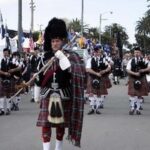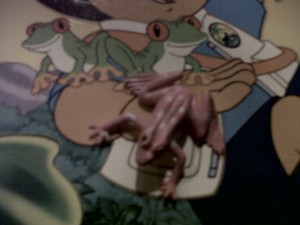One of the most romantic, powerful and dramatic of the symbols of Scotland is the Highland dress recognised throughout the world as Scotland’s national costume.
Today’s kilt, often worn by pipers with a plaid (a long piece of tartan wrapped across the upper part of the body) is a modern version of the “feileadh mor” of old.
According to Matthew A Newsome’s book “Early Highland Dress” the kilt is a remnant of the early Celtic race of Caledonia. The Highlanders of old wore a “feileadh mhor” which is Gaelic for a large piece of woollen tartan material. This will have served a double purpose for the campaigning Scots. They will have wrapped it around their bodies by day, having it belted at the waist and pinned over the shoulder. By night it will have served as a warm blanket. The word “plaid” is from the Gaelic “plaide” meaning blanket. Ancient Celts and Highlanders also wore tight trousers (or “truis”) which were particularly practical when on horseback.
The way in which the Highland Dress has progressed over the centuries reflects the proud character of the Scottish race, their instinct to congregate within family clans or district clans while looking to their Chief as leader. Loyalty to this clan system has influenced Highland Dress and made it a symbol of national pride and brotherhood.
Full Highland Dress, which is evening wear at its finest, is now most likely to be worn on formal occasions and weddings. This would consist of a kilt with kilt pin, a winged-collar white dress shirt and black bow tie. Over this will be a kilt jacket. The kilt will have a dress sporran. Flashes which might match or contrast with the kilt’s tartan are worn on the kilt hose and tucked into the kilt hose is the “Sgiian Dubh” or ornamental knife. Kilt shoes or Ghilie Brogues are worn on the feet. A full plaid (a length of tartan) might also be worn to finish off the outfit.
Formal Highland Dress for ladies depends upon the fashion of the time. A dress should be chosen to compliment the tartan that is being worn. A little convention related to the female Highland dress is that the wives of Chiefs and of the Colonel of the Regiment of Scottish regiments all wear their plaids over the left shoulder. All others wear the sash pinned on the right shoulder.
So traditionally, only clan Chiefs and Commanders of military regiments (and their wives) wear their sash over their left shoulder. Pipers are an exception to this as for practical reasons, the plaid being worn over their left shoulder does not interfere with the shoulder straps of the pipes.
Men’s Day Dress includes a kilt and sporran, shirt, tie, waistcoat and tweed jacket. Kilt stockings with garter flashes and brogue shoes.
Highland Dress Clothing ~
At the heart of the Highland Dress is the kilt which is wrapped around the lower body. It should be pleated at the back and the fringe of the front apron should lie down the right hand side. Straps and buckles hold the kilt firmly in place around the waist. A heavier material is usually used for day kilts.
Highland Jackets, doublets or coatees ~ these vary according to fashion. Elaborate doublets were worn in the 17th century while velvet and tartan doublets and coatees were favoured in the 18th century.
Highland waistcoats ~ these are often made in a fabric matching the jacket or in tartan.
Shirts ~ On less formal occasions such as at the Highland Games, the shirt is favoured. Those shirts with large full sleeves are more costume than National Dress. Those of a military background might wear military-style shirts.
Tartan trousers (or trews) ~ These are popularly used for Highland Dress. It is believed these originated from as far back as the 9th Century as the Book of Kells shows soldiers wearing short truis-like garments which were secured by loops under the foot.
Stockings and flashes ~ Evening stockings are of a lighter material than day stockings which, when out on the hills shooting or stalking, needed to be warm and thick for protection against the prickly heather.
Shoes or Brogues ~ In early times Highlanders would have worn brown moccasins which consisted of pieces of hide pulled together with a thong. By the 18th century footwear had become more sophisticated and Highlanders wore black polished leather. Elaborate brogues are now often also worn with Highland dress.
Belts ~ Belts are normally hidden under jackets or waistcoats. They are normally of black leather with a silver buckle. For evening wear, the buckle mightinclude a heraldic design.
The Skian Dubhs ~ this is the sheathed knife that should be worn on the right side of the right leg in the top of the stocking.
Dirks ~ Silver and ebony dirks with black leather sheaths are often worn by pipers during the day. Normally they are worn by civilians in full Highland Dress.
Sporrans ~ In early times sporrans were made from the skins of small fur bearing animals such as otters, badgers and seals.
Bonnets ~
Cap Badges ~ Members of a clan were allowed to use the Chief’s heraldic crest as a cap or bonnet badge. This was often worn within a buckled strap engraved with the Chief’s motto.
Feathers ~ Only chiefs wear feathers in the bonnet. The Chief would wear three feathers, a chieftain might wear two feathers while a gentleman who has a right to heraldic arms wears one.
There is no set rulebook when wearing Scottish Highland Dress but there are traditions that are generally be followed and as to the question “What do Scots wear under their kilts?” the answer of course is: “Socks and shoes!”



